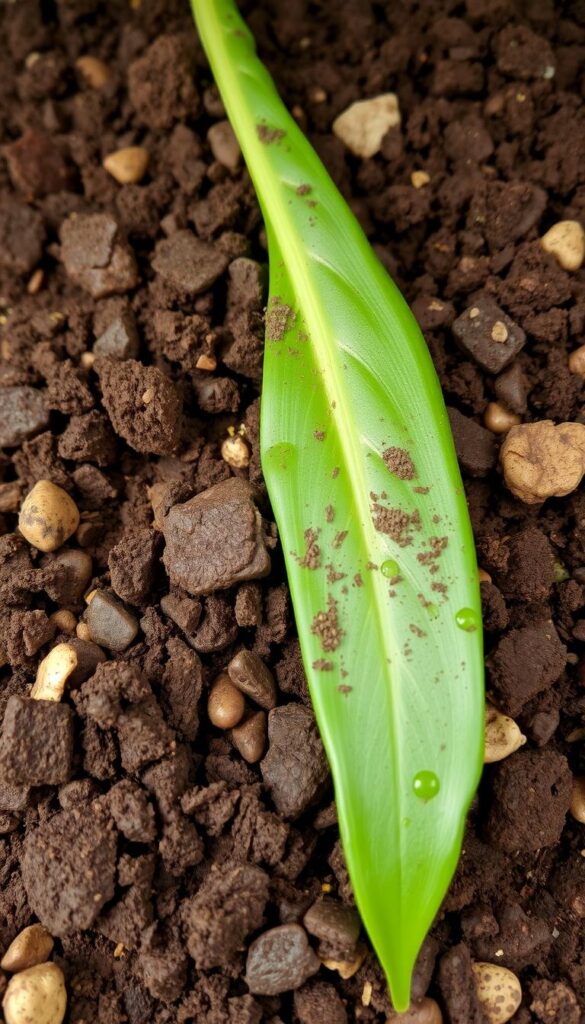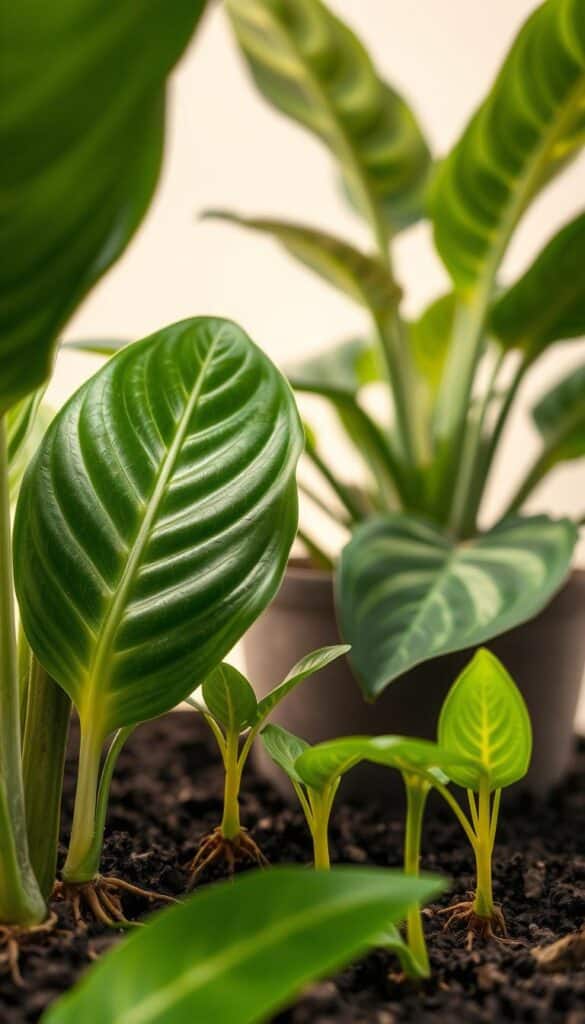My journey with the Philodendron Selloum began like many others—captivated by its stunning, large leaves. This plant quickly became a favorite, transforming my space with its lush foliage. Understanding its unique needs was key to keeping it thriving, and that’s exactly what this guide offers.
The Selloum, also known as Philodendron bipinnatifidum, boasts deeply lobed leaves that add tropical charm to any room. Caring for it involves mastering the balance of water, soil, and light—elements we’ll explore in detail.
Whether you’re a seasoned plant parent or just starting out, this guide serves as your go-to resource. From propagation tips to soil preparation, we’ve covered it all to ensure your Philodendron Selloum flourishes.
Discovering the Philodendron Selloum
My fascination with the Philodendron Selloum began when I first laid eyes on its breathtaking, large leaves. This plant quickly became a favorite, transforming my space with its lush foliage. Understanding its unique needs was key to keeping it thriving, and that’s exactly what this guide offers.
Unique Characteristics and Stunning Foliage
The Selloum, also known as Philodendron bipinnatifidum, boasts deeply lobed leaves that add tropical charm to any room. Caring for it involves mastering the balance of water, soil, and light—elements we’ll explore in detail.
What makes the Selloum truly special is its dramatic foliage. The leaves are deeply lobed, giving them a unique, almost feather-like appearance. The robust stems support these large leaves, creating a striking display that transforms any space.
One of the standout features of the Selloum is its ability to grow both indoors and outdoors. Whether you have a spacious garden or a cozy apartment, this plant adapts beautifully to its environment.
Indoor and Outdoor Growing Considerations
When growing indoors, the Selloum prefers bright, indirect light but can tolerate lower light conditions. Outdoors, it thrives in partial shade, making it a versatile choice for gardeners. The plant’s size can be managed through pruning, allowing it to fit seamlessly into any setting.
| Feature | Indoor | Outdoor |
|---|---|---|
| Lighting | Bright, indirect light | Partial shade |
| Growth | Compact with pruning | Large, sprawling |
| Soil | Well-draining potting mix | Fertile garden soil |
Understanding these characteristics is key to providing the right care. Whether you’re growing the Selloum indoors or outdoors, its unique features make it a standout choice among philodendrons.
Planting and Soil Preparation for Your Selloum
When it comes to nurturing your Selloum, the foundation lies in its soil and planting setup. I’ve learned that selecting the right mix and potting approach can significantly impact the plant’s health and growth.
Choosing the Right Well-Draining Soil
A well-draining soil mix is essential for preventing root rot. I recommend a mix enriched with organic matter like perlite or orchid bark to enhance drainage while retaining moisture. Testing the soil’s acidity is crucial, as the Selloum prefers slightly acidic to neutral soil.
Potting Tips and Optimal Space Requirements
Selecting the right pot and container size allows your plant to grow robustly without overcrowding. I use aeration stones and a drainage layer to ensure proper airflow. Place your Selloum in a spot with controlled conditions to promote healthy growth.

By following these steps, you’ll create an ideal environment for your Selloum to thrive, ensuring it remains a stunning addition to your space.
Watering and Humidity: Avoiding Root Rot
Proper watering is crucial for keeping your Philodendron Selloum healthy. Overwatering can lead to root rot, a common issue that can be avoided with careful practices.
Determining the Correct Moisture Levels
To avoid root rot, I check the soil moisture regularly. I use a soil probe to ensure the top inch of soil is dry before watering again. This helps prevent waterlogged soil.
Allowing the soil to dry slightly between waterings promotes healthy root growth. I adjust my watering schedule based on the plant’s visual cues, like slightly droopy leaves, which signal it’s time to water.
Techniques to Prevent Overwatering
A well-draining potting mix is essential. I add perlite or orchid bark to improve drainage while retaining some moisture. A drainage layer in the pot and a plant saucer help excess water collect properly, preventing root rot.
Humidity management is also key. While the Selloum prefers a humid environment, it’s important to avoid misting the leaves to prevent fungal issues. Instead, I use a humidifier nearby to maintain optimal conditions.
Consistency is vital. I water thoroughly, allowing excess to drain, and wait for the soil to dry slightly before the next watering. This routine keeps the plant thriving without risking root rot.
Lighting and Temperature: Creating an Ideal Environment
Creating the perfect environment for my Philodendron Selloum involves balancing light and temperature to mimic its natural habitat. Bright, indirect light is essential for vibrant foliage, while direct sun can cause leaf burn, creating unattractive marks. To ensure even exposure, I rotate my plant regularly, which also prevents it from leaning towards one side.
Benefits of Bright, Indirect Light
Placing your plant near an east- or west-facing window provides the ideal light conditions. Avoid direct sunlight, especially during peak hours, as it can scorch the leaves. If possible, use sheer curtains to filter the light, ensuring your plant gets the brightness it needs without direct exposure.
Managing Indoor Temperature and Humidity
Maintaining a consistent room temperature between 65°F and 75°F is crucial for healthy growth. Avoid placing your plant near heating or cooling vents to prevent temperature fluctuations. To boost humidity, I use a humidifier or place the plant on a pebble tray with water, creating a microclimate that mimics its tropical origins.
By providing the right balance of light and humidity, your Philodendron Selloum will thrive, rewarding you with lush, tropical foliage that enhances any room.
philodendron selloum care guide: Essential Tips for Thriving Growth
Keeping your Philodendron Selloum in top shape involves a few simple yet effective practices. Regular maintenance ensures your plant stays healthy and vibrant. Below, I’ll share my proven techniques for fertilization, pruning, and propagation.
Fertilization, Pruning, and Maintenance Practices
Feeding your plant is key to its growth. I fertilize monthly with a balanced, water-soluble fertilizer. This routine promotes robust development and vibrant foliage.
Pruning is next. I carefully cut stems to shape the plant and remove any dead leaves. This not only keeps it looking neat but also encourages new growth. Using clean tools helps prevent infections.
To keep your Selloum from outgrowing its space, trim back overgrown stems. This simple step maintains its size and shape, ensuring it remains a perfect fit in your home.
Easy DIY Propagation Methods
Propagating your Philodendron Selloum can be done in a few easy steps. I recommend using stem cuttings. Cut a stem section with at least two nodes, remove lower leaves, and place it in water or a well-draining medium until roots develop.
For a tree-like appearance, train your plant to grow up a trellis. This method, known as the tree philodendron approach, works wonders for managing size and promoting upward growth.
| Tip | Propagation | Pruning |
|---|---|---|
| Monthly feeding with balanced fertilizer | Use stem cuttings in water or medium | Cut stems to shape and remove dead leaves |
| Prune to control size | Roots develop in 1-2 months | Use clean tools to prevent infection |

By following these care tips, your Philodendron Selloum will thrive, providing you with years of beautiful foliage and a lush, tropical atmosphere in your home.
Troubleshooting Common Issues and Pest Management
Even with the best care, your Philodendron Selloum might face some challenges. Let’s explore how to identify and address these issues effectively.
Identifying Disease, Yellowing Leaves, and Root Problems
One of the most common signs of a problem is yellowing leaves. This could indicate overwatering, which can lead to root rot. I check the soil moisture and adjust my watering schedule if needed. Mushy roots are another sign of root problems, so ensuring proper drainage is crucial.
- Yellowing leaves can signal overwatering or poor drainage.
- Mushy roots indicate root rot, requiring immediate attention.
Effective Strategies for Pest Control
Pests like spider mites or mealybugs can infest your plant. Early detection is key to preventing a full infestation. I use neem oil or insecticidal soap to treat the plant, ensuring a pest-free environment.
- Regularly inspect leaves for pests.
- Use neem oil or insecticidal soap for treatment.
By addressing these issues promptly, you can keep your plant healthy and thriving.
Wrapping Up Your Philodendron Journey: Next Steps for Continued Success
As I reflect on my journey with the Philodendron Selloum, I’m reminded of the incredible progress I’ve witnessed over time. This plant has grown from a small specimen into a lush, towering beauty, its large leaves a testament to the power of consistent care.
Maintaining a routine has been key to its success. By balancing water, light, and regular maintenance, I’ve seen my Selloum thrive. It’s a journey that requires patience and persistence, as every houseplant’s path is unique.
Even when challenges arise, understanding the plant’s needs keeps it flourishing. Observing growth patterns and adjusting care practices ensures it continues to grow strong and healthy.
My hope is that you find inspiration in this journey. With dedication, even a tree philodendron can become a stunning centerpiece in any home, bringing joy and beauty to your space.
